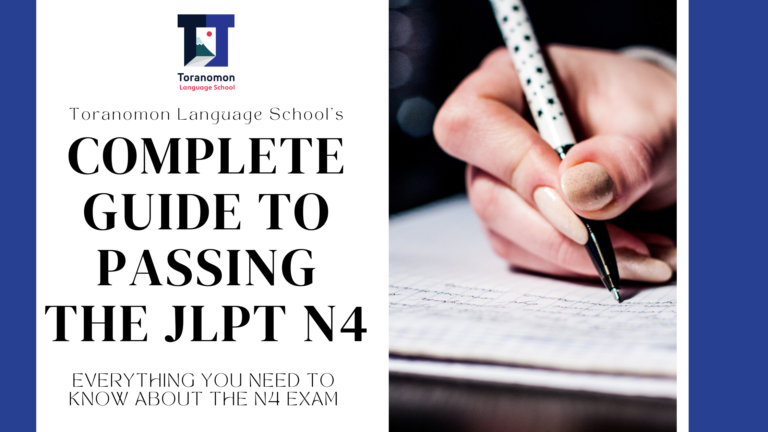Prepare for the JLPT N4 exam with this JLPT guide! Learn all about the structure of the test, study techniques and more to successfully pass in 2024.
Are you ready to take the JLPT N4 exam? This guide will help you understand the structure of the exam, prepare with effective study techniques and gain the confidence to pass this test, as well as what Toranomon Language School can offer you to help you with your studies.

What is the JLPT?
What exactly is the JLPT? The JLPT, also known as the Japanese-Language Proficiency Test or 日本語能力試験, is an exam designed to measure the Japanese proficiency of non-native Japanese speakers. It’s commonly used by universities and employers both in and outside Japan, and it’s offered twice a year within Japan, as well as in a few other countries. Those who plan on living, working, or studying in Japan often take the JLPT exams to demonstrate their Japanese language skills.
What are the levels for the JLPT?
There are five different levels of the JLPT: N1, N2, N3, N4, and N5, with N5 being the most basic and N1 being the most advanced. The N4 and N5 levels test basic Japanese learned from a textbook, while N1 and N2 are much more advanced and test takers can usually hold their own in the language by that point. The N3 level is somewhere in between.
If you’re not sure if you are an N4 or N5 level, check out this guide to each test.

Why should I take the JLPT N4?
For those seeking employment in Japan, JLPT scores can be quite useful. Many jobs require N2 level minimum. Passing the N2 or N1 levels can even qualify individuals for preferential treatment when immigrating to Japan, or get you noticed by a potential employer.
While not so useful for employment, the N4 Exam can still be a valuable goal for Japanese learners. It can serve as a short-term target and help learners discover their strengths and weaknesses. If you can pass N4, you can get by in this country. You have the basic skills to have conversations, go to clinics, talk to teachers, and so on. You won’t be perfect and you won’t have a full vocabulary, but you can get by.

An overview of the JLPT N4
The JLPT N4 exam is for beginners with experience. You have passed the basics like days of the week and numbers, but you are not yet able to have sophisticated conversations. The test will cover things like:
- Reading passages about daily topics, including basic kanji
- Listen and answer questions about daily topics, at a slightly slower speed than real life
- Usage of vocabulary at the N4 level
The questions are fairly clear, and are not yet designed to trip you up.
There are three sections on the exam:
- Vocabulary (kanji, spelling, expressions, orthography and paraphrasing)
- Grammar and Reading (forming sentences in the correct order, using the right verb form, reading comprehension for short and mid-length passages)
- Listening
For the JLPT N4 exam you will need to know around 1,500 vocabulary words as well as the first 300 kanji.
This means everything covered in the N5 exam (the basics), plus more. The vocabulary will be much wider than that from the N5, including not only the basics like days of the week, but also words commonly used in the workplace, supermarkets, restaurants and so on. If you are looking for a course to help make sure you have covered all the content, our private lessons can help.
You need to know how to use particles:
| 1 | は (wa) |
| 2 | か (ka) |
| 3 | が (ga) |
| 4 | に (ni) |
| 5 | へ (e) |
| 6 | を (wo/o) |
| 7 | と (to) |
| 8 | や (ya) |
| 9 | など (nado) |
| 10 | も (mo) |
| 11 | で (de) |
| 12 | の (no) |
| 13 | から (kara) |
| 14 | まで (made) |
If you are having trouble with particles, check out our ultimate guide to particles in Japanese.
You need to know how to conjugate verbs in several forms:
- -masu/masen
- -mashita/masendeshita
- -plain form in past and present, positive and negative
- -te form
TLS offers a JLPT N4 preparation course – click here for details.
How is the JLPT N5 scored? What’s the pass mark?
Vocab, grammar and reading can give you a total of 120 points, while the listening section is out of 60 points. So your overall score will be between 0-180 points, with a pass being 90+ points.
Vocabulary, grammar, reading: 0-120 points
Listening: 0-60 points
Total score: 0-180 points
Pass: 90 points (must have 38 points in Vocabulary, grammar, reading and 19 points in listening to pass)
How long is the exam?
Each section has a different time length.
- Vocabulary – 25 minutes
- Grammar and reading – 55 minutes
- Listening – 35 minutes
The exam lasts for 115 minutes in total.

Here are the main points to remember when revising for the JLPT N4
⚫ Get familiar with the JLPT N4 structure and content
Before starting to study for the JLPT N4 exam, you should first be familiar with the structure and types of questions it will include. The test is divided into three sections that assess your knowledge of vocabulary, grammar, reading comprehension and listening ability. Each section consists of multiple-choice and written pieces that range in difficulty level. The structure of the N4 is below.
PART 1: VOCABULARY
- Kanji reading (How to read the kanji)
- Orthography (test kanji for words written in hiragana)
- Contextually-defined expressions (test words whose meaning is defined by context)
- Paraphrases (test of words and expressions with similar meanings)
- Usage (Are you using the correct word?)
PART 2: READING AND GRAMMAR
- Select the correct grammar form
- Create the correct sentence composition
- Use the correct grammar in a sentence
- Short-passage comprehension (100-200 characters involving topics like study, life and work)
- Mid-length passage comprehension (450 characters on everyday topics)
- Information retrieval (Can you retrieve the relevant information from materials such as notices, about 400 characters)
PART 3: LISTENING
- Task-based comprehension (testing ability to extract the ncessary information from the listening in order to answer the question)
- Comprehension of key points (testing if you can narrow down the correct answer based on the listening)
- Verbal expressions (test ability to select appropriate verbal expressions by listening to circumstances while looking at illustrations)
- Quick response (test ability to select appropriate responses by listening to short utterances such as questions)
We recommend doing many practice tests in order to be properly familiar with the structure.
If you want help from a Japanese teacher in your preparation, TLS has ample experience in JLPT preparation.
⚫ Learn essential grammar and vocabulary
Japanese grammar and vocabulary are essential components of the N4 exam. To prepare for the test, make sure to review basic vocabulary for topics such as pronouns, nouns, question words, adjectives and modifiers. There are plenty of resources for this on the Web, such as this list.
Remember to become familiar with any special expressions or phrases related to the language that are commonly used in Japan (like それはいけませんね = That’s no good).
For the kanji aspect, possibly the most difficult part of the test, Toranomon Language School offers a kanji prep course for those needing an extra boost – sign up for a private lesson and the lesson structure will be created according to your needs.
⚫ Utilize JLPT N4 preparation materials effectively
When preparing for the JLPT N4 exam, utilize flashcards, practice tests, worksheets and grammar books specifically tailored to the N4 exam. If you are studying hard but find yourself stuck on a certain concept or vocabulary word, consider an online resource or forum for additional help. Additionally, many online courses now offer access to virtual classrooms which can be beneficial for learning with peers, asking questions and getting feedback from an instructor.
We can make special materials for you based on your weaknesses and what you most need to work on.
⚫ Develop strategies for each kind of question in advance of the test day
Developing a set of strategies for each type of question helps to ensure that you approach the exam with an effective plan. Take the time to review all types of questions and use practice tests to practice different approaches, such as memorizing kanji or vocab words faster, understanding grammar patterns quickly and efficiently, or finding information quickly in a passage. For example, you could read the questions before reading the passage, so that you know what the key points are when reading the text.
Your course teacher at Toranomon Language School can help you strategize if you enroll in a course.
⚫ On the day
Remember to arrive early (any time from 11:45am) and bring your pencils, erasers, test voucher, and a watch. When you arrive, show your voucher and staff will direct you to a room.
How to register for 2024:
Next Test Date: TBA
Application Method: Apply using the MyJLPT JLPT Application page after registering with MyJLPT on the JLPT website of Japan Educational Exchanges and Services (JESS).
Test Fee: 6,500 yen
Payment Methods: Credit card, bank transfer, payment at a convenience store.
After you register, you will receive more information in the post.
For more information, visit the JLPT Official Website. https://www.jlpt.jp/e/

